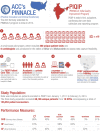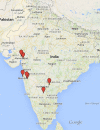Cardiovascular Disease Performance Measures in the Outpatient Setting in India: Insights From the American College of Cardiology's PINNACLE India Quality Improvement Program (PIQIP)
- PMID: 25994444
- PMCID: PMC4599418
- DOI: 10.1161/JAHA.115.001910
Cardiovascular Disease Performance Measures in the Outpatient Setting in India: Insights From the American College of Cardiology's PINNACLE India Quality Improvement Program (PIQIP)
Abstract
Background: India has a growing burden of cardiovascular disease (CVD), yet data on the quality of outpatient care for patients with coronary artery disease, heart failure, and atrial fibrillation in India are very limited. We collected data on performance measures for 68 196 unique patients from 10 Indian cardiology outpatient departments from January 1, 2011, to February 5, 2014, in the American College of Cardiology's PINNACLE (Practice Innovation and Clinical Excellence) India Quality Improvement Program (PIQIP). PIQIP is India's first national outpatient CVD quality-improvement program.
Methods and results: In the PIQIP registry, we estimated the prevalence of CVD risk factors (hypertension, diabetes, dyslipidemia, and current tobacco use) and CVD among outpatients. We examined adherence with performance measures established by the American College of Cardiology, the American Heart Association, and the American Medical Association Physician Consortium for Performance Improvement for coronary artery disease, heart failure, and atrial fibrillation. There were a total of 68 196 patients (155 953 patient encounters), with a mean age of 50.6 years (SD 18.2 years). Hypertension was present in 29.7% of patients, followed by diabetes (14.9%), current tobacco use (7.6%), and dyslipidemia (6.5%). Coronary artery disease was present in 14.8%, heart failure was noted in 4.0%, and atrial fibrillation was present in 0.5% of patients. Among eligible patients, the reported use of medications was as follows: aspirin in 48.6%, clopidogrel in 37.1%, and statin-based lipid-lowering therapy in 50.6% of patients with coronary artery disease; RAAS (renin-angiotensin-aldosterone system) antagonist in 61.9% and beta-blockers in 58.1% of patients with heart failure; and oral anticoagulants in 37.0% of patients with atrial fibrillation.
Conclusions: This pilot study, initiated to improve outpatient CVD care in India, presents our preliminary results and barriers to data collection and demonstrates that such an initiative is feasible in a resource-limited environment. In addition, we attempted to outline areas for further improvement in outpatient CVD care delivery in India.
Keywords: American College of Cardiology; India; PINNACLE India Quality Improvement Project (PIQIP); Practice Innovation and Clinical Excellence (PINNACLE); performance measure; quality improvement.
© 2015 The Authors. Published on behalf of the American Heart Association, Inc., by Wiley Blackwell.
Figures


References
-
- Population, total. Source: World Bank. Available at: http://data.worldbank.org/indicator/SP.POP.TOTL.Accessed March 21, 2015.
-
- Murthy PD, Prasad KT, Gopal PV, Rao KV, Rao RM. A survey for prevalence of coronary artery disease and its risk factors in an urban population in Andhra Pradesh. J Assoc Physicians India. 2012;60:17–20. - PubMed
-
- Goyal A, Yusuf S. The burden of cardiovascular disease in the Indian subcontinent. Indian J Med Res. 2006;124:235–244. - PubMed
-
- DeMaria AN. Cardiology in India. J Am Coll Cardiol. 2010;56:678–679. - PubMed
-
- Thankappan KR, Shah B, Mathur P, Sarma PS, Srinivas G, Mini GK, Daivadanam M, Soman B, Vasan RS. Risk factor profile for chronic non-communicable diseases: results of a community-based study in Kerala, India. Indian J Med Res. 2010;131:53–63. - PubMed
Publication types
MeSH terms
Grants and funding
LinkOut - more resources
Full Text Sources

